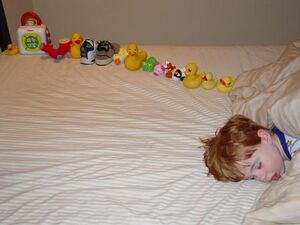
A young boy with autism, and the precise line of toys that he made before falling asleep.
Autistic children may display unusual behaviors or fail to display expected behaviors.
Some behaviors cited by the National Institute of Child Health and Human Development (listed below) may simply mean a normal delay in one or more areas of development, while others are more typical of autism spectrum disorders. [1]
The list below is not all-inclusive, and generally applies to children and not adults. Furthermore, while some of these behaviors might be seen in a person with autism, others may be absent.
- stares into open areas, doesn't focus on anything specific.
- does not respond to his/her name.
- cannot explain what he/she wants.
- language skills are slow to develop or speech is delayed.
- doesn't follow directions.
- will fuss if didn't get what wanted.
- at times, the child seems to be deaf.
- doesn't point or wave "bye-bye."
- doesn't understand the concept of pointing; will look at the hand pointing rather than the object being pointed at.
- used to say a few words or babble, but now he/she doesn't.
- throws intense or violent tantrums.
- has odd movement patterns.
- likes to spin around in a circle.
- likes being in a place well known.
- hands on ears often.
- is overly active, uncooperative, or resistant.
- doesn't know how to play with toys.
- doesn't smile when smiled at.
- has poor eye contact.
- gets "stuck" doing the same things over and over and can't move on to other things.
- seems to prefer to play alone.
- gets things for him/herself only.
- is very independent for his/her age.
- does things "early" compared to other children.
- seems to be in his/her "own world."
- seems to tune people out.
- is not interested in other children.
- dislikes playing pretend.
- walks on his/her toes.
- shows unusual attachments to toys, objects, or schedules (e.g., always holding a string or having to put socks on before pants).
- spends a lot of time stacking objects, lining things up or putting things in a certain order.
- unconcerned about - or completely oblivious to - dangers around him/her (e.g., standing in the middle of the street without worrying about getting hit by a car).
Template:Wikipedia
- ↑ "Autism Overview: What we know" Filipek et al. (1999). Screening and diagnosis of autistic spectrum disorders. Journal of Autism and Developmental Disorders, 29(6): 439-484. Cited in NICHD publications reference. Retrieved 26 January 2007
